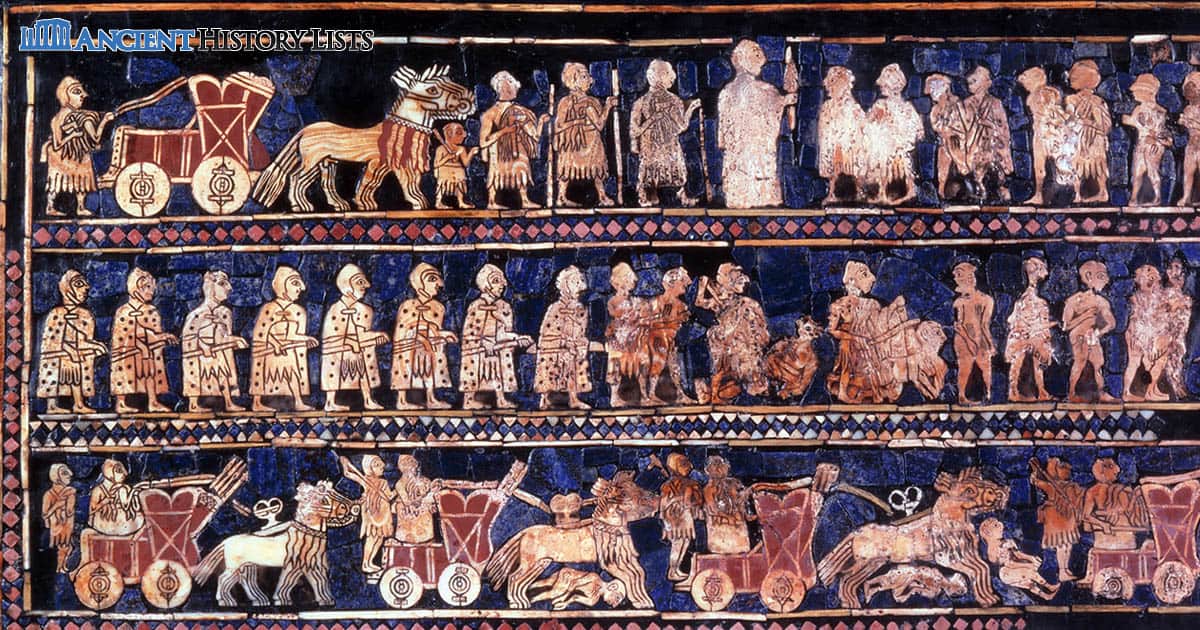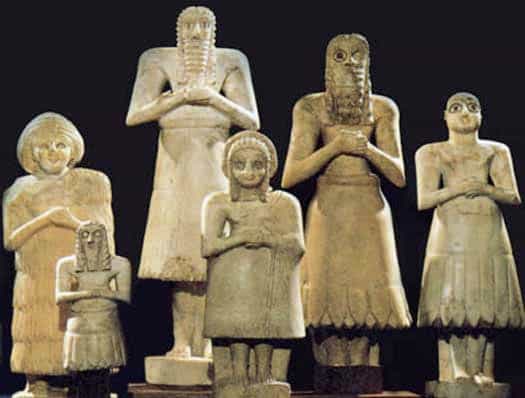5:The Standard of Ur

Found in the 1920s by British archeologists (Iraq was then governed by Britain), the Standard of Ur is a beautiful piece of art that is 4,600 years old. The standard is actually a mosaic, not a piece of cloth as the name would suggest. Though much of the piece has been lost to time and thieves, a significant portion of it exists today in the British Museum in London.
The Standard is made from red limestone and lapis lazuli (which forms the blue background). These materials were not cheap, and the mosaic was prepared for the tomb of a king, Ur-Pabilsag, who died around 2550 BC. The mosaic is a partial story of his life and reign and gives us an insight into Mesopotamian culture.
Originally believed to be covering a hollow, four-sided box, the mosaic is actually quite small – 8.5 inches wide and 19.5 inches long – but provides great detail about aspects of life in ancient Mesopotamia. The two surviving fragments have been labeled “War” and “Peace.” The first shows the king, a two-dimensional, towering figure, viewing a procession of naked prisoners (some of them wounded) being marched past his chariot. Mesopotamian soldiers are shown in their helmets with weapons at the ready.
We also see a number of horse-drawn chariots. From these images, we know what these soldiers wore, and with what (and how) they likely fought. The horses lack bits in their mouths as this was an invention that came a thousand years later. Instead, they were directed by other means such as ropes along or inside the nose. Enemies are being paraded before them and are being trampled underneath the chariots.
The other fragment, “Peace,” again shows an outsized king at the head of a banquet, which includes a singer, a lyre player, fish and other animals, as well as various fruits and vegetables.
6:Statues of Tell Asmar

In the 2009 movie The Fourth Kind, a psychologist works with people who have allegedly been abducted and their bodies inhabited by aliens and subjected to all sorts of terrors. Soon, she is visited by these aliens herself and begins to record their visits. She also hires a team of UFO experts to help her get to the bottom of the mystery.
One of these experts is a historian who has traced alien abduction and visitation stories throughout history. It is his belief that beings from another planet have been visiting the earth for thousands of years. To “prove” his theory, he points out various statues and friezes of the Sumerian and other Mesopotamian cultures such as the Elamites of the powerful city of Eshnunna.
Two of the figures he believes might be depictions of aliens are the votive statues of Tell Asmar from around 2700 BC. Their large eyes are similar to those that we associate with visiting aliens. Other plausible-sounding similarities are concocted to lead us to believe that perhaps aliens have been visiting and ruling over us for centuries.
The true story of the figures is this: Just as worshipers light a candle and say a prayer to remember their loved ones in some Christian churches today, these statues represented the deceased. In many cases, names have been found on the bottom of the figures, along with a written prayer.
Collection of Figures:
The twelve figures of Tell Asmar (ten men and two women) were found close together in a temple area. It is believed that the wide, alien-like eyes of the statuettes were to make sure that they were able to see any messages or responses given by the gods, no matter how small or subtle.
Eight of the statues are made from gypsum, two from limestone and one from alabaster. The dark, oversized eyes are made from bitumen (coal) and one figure’s pupils are made from lapis lazuli. The beards of the men and other dark markings and shadings on the figures were also inlays of bitumen coal.





0 Comments